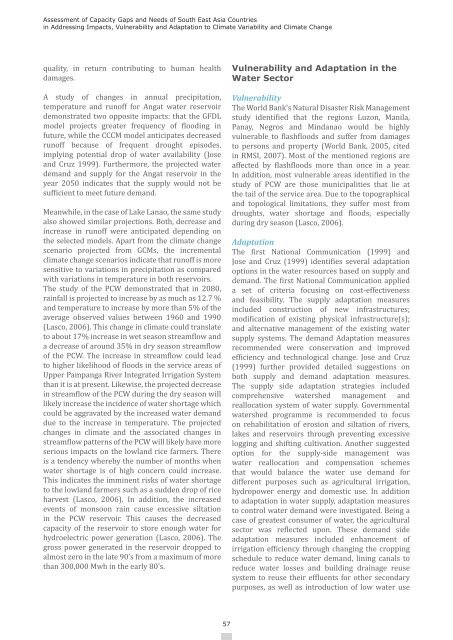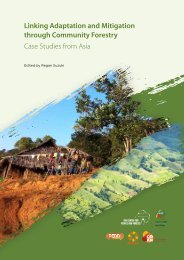Desktop Study on - Regional Climate Change Adaptation ...
Desktop Study on - Regional Climate Change Adaptation ...
Desktop Study on - Regional Climate Change Adaptation ...
Create successful ePaper yourself
Turn your PDF publications into a flip-book with our unique Google optimized e-Paper software.
Assessment of Capacity Gaps and Needs of South East Asia Countries<br />
in Addressing Impacts, Vulnerability and Adaptati<strong>on</strong> to <strong>Climate</strong> Variability and <strong>Climate</strong> <strong>Change</strong><br />
quality, in return c<strong>on</strong>tributing to human health<br />
damages.<br />
A study of changes in annual precipitati<strong>on</strong>,<br />
temperature and runoff for Angat water reservoir<br />
dem<strong>on</strong>strated two opposite impacts: that the GFDL<br />
model projects greater frequency of flooding in<br />
future, while the CCCM model anticipates decreased<br />
runoff because of frequent drought episodes,<br />
implying potential drop of water availability (Jose<br />
and Cruz 1999). Furthermore, the projected water<br />
demand and supply for the Angat reservoir in the<br />
year 2050 indicates that the supply would not be<br />
sufficient to meet future demand.<br />
Meanwhile, in the case of Lake Lanao, the same study<br />
also showed similar projecti<strong>on</strong>s. Both, decrease and<br />
increase in runoff were anticipated depending <strong>on</strong><br />
the selected models. Apart from the climate change<br />
scenario projected from GCMs, the incremental<br />
climate change scenarios indicate that runoff is more<br />
sensitive to variati<strong>on</strong>s in precipitati<strong>on</strong> as compared<br />
with variati<strong>on</strong>s in temperature in both reservoirs.<br />
The study of the PCW dem<strong>on</strong>strated that in 2080,<br />
rainfall is projected to increase by as much as 12.7 %<br />
and temperature to increase by more than 5% of the<br />
average observed values between 1960 and 1990<br />
(Lasco, 2006). This change in climate could translate<br />
to about 17% increase in wet seas<strong>on</strong> streamflow and<br />
a decrease of around 35% in dry seas<strong>on</strong> streamflow<br />
of the PCW. The increase in streamflow could lead<br />
to higher likelihood of floods in the service areas of<br />
Upper Pampanga River Integrated Irrigati<strong>on</strong> System<br />
than it is at present. Likewise, the projected decrease<br />
in streamflow of the PCW during the dry seas<strong>on</strong> will<br />
likely increase the incidence of water shortage which<br />
could be aggravated by the increased water demand<br />
due to the increase in temperature. The projected<br />
changes in climate and the associated changes in<br />
streamflow patterns of the PCW will likely have more<br />
serious impacts <strong>on</strong> the lowland rice farmers. There<br />
is a tendency whereby the number of m<strong>on</strong>ths when<br />
water shortage is of high c<strong>on</strong>cern could increase.<br />
This indicates the imminent risks of water shortage<br />
to the lowland farmers such as a sudden drop of rice<br />
harvest (Lasco, 2006). In additi<strong>on</strong>, the increased<br />
events of m<strong>on</strong>so<strong>on</strong> rain cause excessive siltati<strong>on</strong><br />
in the PCW reservoir. This causes the decreased<br />
capacity of the reservoir to store enough water for<br />
hydroelectric power generati<strong>on</strong> (Lasco, 2006). The<br />
gross power generated in the reservoir dropped to<br />
almost zero in the late 90’s from a maximum of more<br />
than 300,000 Mwh in the early 80’s.<br />
Vulnerability and Adaptati<strong>on</strong> in the<br />
Water Sector<br />
Vulnerability<br />
The World Bank’s Natural Disaster Risk Management<br />
study identified that the regi<strong>on</strong>s Luz<strong>on</strong>, Manila,<br />
Panay, Negros and Mindanao would be highly<br />
vulnerable to flashfloods and suffer from damages<br />
to pers<strong>on</strong>s and property (World Bank, 2005, cited<br />
in RMSI, 2007). Most of the menti<strong>on</strong>ed regi<strong>on</strong>s are<br />
affected by flashfloods more than <strong>on</strong>ce in a year.<br />
In additi<strong>on</strong>, most vulnerable areas identified in the<br />
study of PCW are those municipalities that lie at<br />
the tail of the service area. Due to the topographical<br />
and topological limitati<strong>on</strong>s, they suffer most from<br />
droughts, water shortage and floods, especially<br />
during dry seas<strong>on</strong> (Lasco, 2006).<br />
Adaptati<strong>on</strong><br />
The first Nati<strong>on</strong>al Communicati<strong>on</strong> (1999) and<br />
Jose and Cruz (1999) identifies several adaptati<strong>on</strong><br />
opti<strong>on</strong>s in the water resources based <strong>on</strong> supply and<br />
demand. The first Nati<strong>on</strong>al Communicati<strong>on</strong> applied<br />
a set of criteria focusing <strong>on</strong> cost-effectiveness<br />
and feasibility. The supply adaptati<strong>on</strong> measures<br />
included c<strong>on</strong>structi<strong>on</strong> of new infrastructures;<br />
modificati<strong>on</strong> of existing physical infrastructure(s);<br />
and alternative management of the existing water<br />
supply systems. The demand Adaptati<strong>on</strong> measures<br />
recommended were c<strong>on</strong>servati<strong>on</strong> and improved<br />
efficiency and technological change. Jose and Cruz<br />
(1999) further provided detailed suggesti<strong>on</strong>s <strong>on</strong><br />
both supply and demand adaptati<strong>on</strong> measures.<br />
The supply side adaptati<strong>on</strong> strategies included<br />
comprehensive watershed management and<br />
reallocati<strong>on</strong> system of water supply. Governmental<br />
watershed programme is recommended to focus<br />
<strong>on</strong> rehabilitati<strong>on</strong> of erosi<strong>on</strong> and siltati<strong>on</strong> of rivers,<br />
lakes and reservoirs through preventing excessive<br />
logging and shifting cultivati<strong>on</strong>. Another suggested<br />
opti<strong>on</strong> for the supply-side management was<br />
water reallocati<strong>on</strong> and compensati<strong>on</strong> schemes<br />
that would balance the water use demand for<br />
different purposes such as agricultural irrigati<strong>on</strong>,<br />
hydropower energy and domestic use. In additi<strong>on</strong><br />
to adaptati<strong>on</strong> in water supply, adaptati<strong>on</strong> measures<br />
to c<strong>on</strong>trol water demand were investigated. Being a<br />
case of greatest c<strong>on</strong>sumer of water, the agricultural<br />
sector was reflected up<strong>on</strong>. These demand side<br />
adaptati<strong>on</strong> measures included enhancement of<br />
irrigati<strong>on</strong> efficiency through changing the cropping<br />
schedule to reduce water demand, lining canals to<br />
reduce water losses and building drainage reuse<br />
system to reuse their effluents for other sec<strong>on</strong>dary<br />
purposes, as well as introducti<strong>on</strong> of low water use<br />
57

















